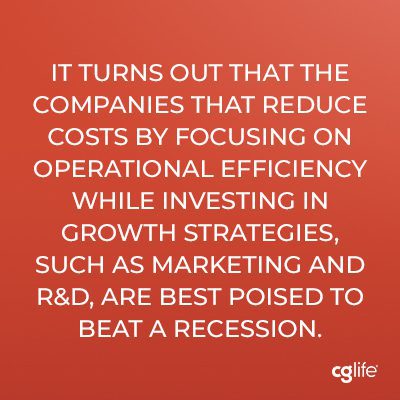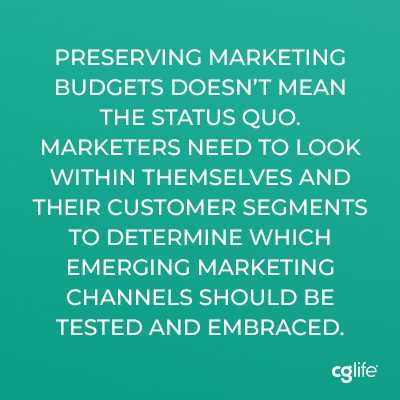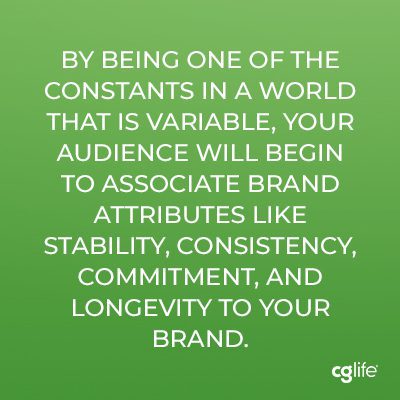The original version ofthis article was published on Forbes on April 3rd, 2020
While uncertainty is reigning during the current global pandemic, economic indicators are pointing to a coming recession, if we are not already there. The speed and depth of a recession vary depending upon which talking head TV pundit you choose to listen to, but for marketers, there are certainties to which we can all cling.
Put a laser focus on existing customers, clients, and partners.
Now is not the time to ignore the business you have. Place more emphasis on inside sales to your current customers. There are a ton of studies that show the higher cost of acquiring a new customer relative to nurturing a current relationship. Remember that those “clients” are people, and they’re struggling with the same business challenges and decisions that you are facing.
So, speak to them. Reach out and see how they’re doing. Find out what is keeping them awake at night. A crisis is not a time for selling products and services. A crisis is a time to be a partner and a friend. Those relationships will strengthen as a result and will likely bear fruit when the market returns.
For example, as the COVID-19 pandemic broke, I sent a note to a longtime client that simply asked how they were doing, and I meant it. Simple, short, and genuine. His response: “We are well and thanks for reaching out. Your email was nice to read: simple yet compassionate… a refreshing alternative to many of the lengthy updates we are getting from companies on their various states of preparedness for business continuity.”
Remind management that a recession doesn’t mean a retreat from marketing.

As Henry Ford once said, “A man who stops advertising to save money is like a man who stops a clock to save time.” When recessions hit, marketing is often among the first budget cuts. Doing so could potentially cause long-term damage to the brand and allow smaller or weaker competitors to steal market share. There are countless studies going back more than a decade showing that brands maintaining or increasing advertising during a recession gain market share over time.
A March 2010 study tracked the performance and recovery of 4,700 companies through the 2008-2009 recession. Of those companies, 17% went bankrupt, became private, or were acquired. Roughly 80% did not reach full recovery until three years after the recession ended. But 9% thrived. Why? It turns out that the companies that reduce costs by focusing on operational efficiency while investing in growth strategies, such as marketing and R&D, are best poised to beat a recession.
Be nimble and open-minded to new technologies, tools, and platforms.

Preserving marketing budgets doesn’t mean the status quo. Marketers need to look within themselves and their customer segments to determine which emerging marketing channels should be tested and embraced.
Procter & Gamble came out of the Great Depression as a much stronger brand than it was when the stock market crashed in 1929. Instead of cutting back its advertising in cost-cutting efforts, the company shifted its marketing dollars into new marketing channels, including radio. In a 10-year span, P&G sponsored a handful of soap operas. This was the original content marketing plan execution.
During the last two recessions, new channels have emerged. Think about the advent of social media in the early 2000s after the dot-com bubble burst. Some marketing change agents saw the opportunity to use these platforms to reach audiences quickly and in targeted ways.
Use the time to focus on strategy, build content, and analyze your customers’ behaviors.
Acknowledge that customer behavior is going to change as a result of the changing environment. Use data to anticipate what you believe your customer will be looking to do, and use marketing to be there waiting.
One of the most successful businesses during the 2008 recession came as a result of a wholesale business model change. Long before Netflix began producing award-winning movies like The Irishman , Netflix ran a profitable video-rental-by-mail business. When home Wi-Fi and a high recessionary unemployment rate created demand, the company shifted its model to provide video-on-demand through Comcast or Apple. Netflix gained members during the peak of the recession in 2009.
While the change was aided by advancements in technology, at the heart of the change was a careful analysis of customer behavior. This sort of careful reexamination of customer behavior is critical to controlling the company direction in the recovery.
Use the time going into a tougher economy to build assets, materials, and programs while you have access to resources.
Remember those few marketing assets or creative materials that you’ve been meaning to get to? Now is the time to push them through. Without trying to be too dark, management may take away internal or external resources or budgets. Use them while you have them to build tools that your marketing program will need to ride out the tighter period.
Longer-term, there is no doubt that spending on virtual events and advanced digital engagement capabilities will increase. Plus, as remote work increasingly becomes the new norm, expect a dramatic rise in virtual reality (VR) and augmented reality (AR) content and similar digital technologies.
Provide certainty when people are overwhelmed with uncertainty.
Psychologically, brand consistency during uncertain times can gain brand loyalty. By being one of the constants in a world that is variable, your audience will begin to associate brand attributes like stability, consistency, commitment, and longevity to your brand. Don’t believe me? Half of the top 10 most trusted brands are nearly a century old.
In marketing as in life, certainty is a scarcity in this world. As marketers and people, if we can provide just a bit of level-headed thinking and stability, we will find that we will have a community following and cheering us on when the skies clear. And clear they will.

For other advice for managing your business during uncertain times, check out our blogs on trade show contingency marketing, media outreach, connecting with your team while working from home, crisis communications, and preparing your business for re-entry.
Otherwise, if you’d like to discuss how CG Life can assist your marketing efforts for your products, devices, and services, contact us!
